By Jacob Hamilton, General Manager at Tim Ferguson Plumbing, Air & Electric When my father-in-law called me into his office on an afternoon in 2010, I didn’t know my life was about to change. I had been working as a nurse before joining his plumbing business, Tim Ferguson Plumbing, Air & Electric, jumping headfirst into Read more
Featured
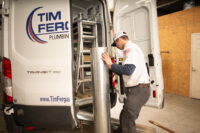
By Jacob Hamilton, General Manager at Tim Ferguson Plumbing, Air & Electric
When my father-in-law called me into his office on an afternoon in 2010, I didn’t know my life was about to change.
I had been working as a nurse before joining his plumbing business, Tim Ferguson Plumbing, Air & Electric, jumping headfirst into a new industry I knew nothing about. But Tim trusted me to learn and saw something in me then that I couldn’t see in myself.
During our meeting, he laid out his plan for me: He wanted me to help continue to build the family business and take over when he retired. I told him I knew nothing about how to run a company; but I could sense he had complete confidence in my ability to learn. And I knew that, if he believed in me, for something as important as leading the family business into a new generation, I should trust his plan.
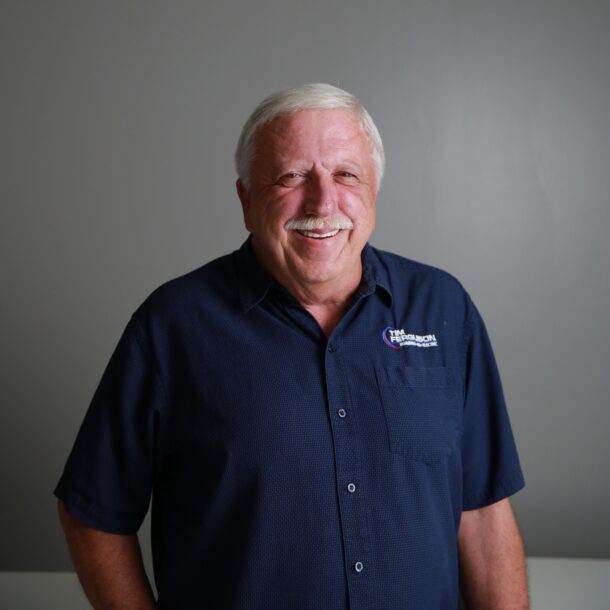
Tim Ferguson
It was Tim’s foresight and commitment to long-term planning that made his dream come to fruition when he sold the company to Leap Partners and retired. I took over on Oct. 1, 2023.
Leadership transitions are hard. But it was Tim’s patience and long-term planning that helped us all smoothly transition with minimal disruption. His intuition also prepared our 45 employees and me to easily and naturally transition into a new era and continue the legacy he’d built over more than 20 years.
How did we do it? Let me share some lessons we learned along the way.
Communicate, communicate, communicate
Without question, the most important piece of advice I can give to anyone undergoing a leadership transition is to communicate consistently. It’s imperative that you communicate clearly and often with your employees about your plans for leadership. You don’t want employees to fill in gaps with hearsay, and you definitely don’t want them to hear two conflicting or muddled messages at the same time. Overcommunicating is always going to be better than not communicating enough.
Let them know the plan, when it’s happening and how you expect the transition to go. If you don’t know the answers to some of these questions, let them know that too. Listening to feedback and being transparent will help cut down on the feeling of unease that can come with change. Treating all employees like integral partners in the business by being overly transparent with them can make everyone feel invested in what’s happening. Especially with small businesses, your team should feel comfortable with the transition and feel that their input is being considered.
Anticipate challenges and plan for them
How am I going to deal with the potential of losing managers or technicians? What if people don’t like the new leader? When should we change over? These are all normal questions to have, and it’s crucial to fully think through the answers before any plan is put into action.
Run through every scenario in your head and create a rational plan for each. Find the solution that will have the smallest impact on your business, and make sure you consult with your leadership team for feedback.
An aspect that is often overlooked is the timing of your transition. As best you can, try to implement your transition plan during a time of year that’s comfortable or slower for your industry. In our business, we know summers are often draining on our employees, so we looked at September or October to start transitioning duties rather than during the intensive summer period.
Give thought to potential pitfalls, and make sure you plan accordingly so you don’t panic when they arise.
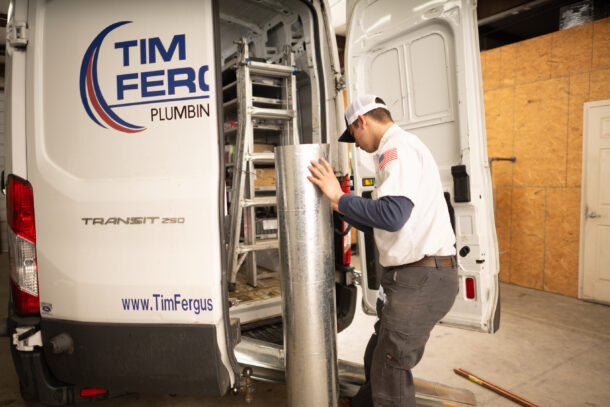
It’s never too early to start planning
A lot of the success in Tim’s transition plan was due to his foresight and patience. Just as he did with me for the better part of a decade, I’m looking ahead and thinking about how I can prepare the next generation of company leaders.
There are many aspects to leading a business that you have to just learn in the role, but there are other skills that come naturally to any good leader. Identify those rising leaders with exceptional listening skills, emotional intelligence and strategic foresight. Engage them in tasks that foster the development of these skills and provide leadership opportunities where you can, preparing them for larger future roles.
Starting this process early will save you time and potential headaches down the road. If you’re not sure where to start, don’t be afraid to ask for help. We had the support of our parent company Leap Partners to help guide us through our transition, and their advice and helping hand were vital to our success.
A smooth transition of leadership does not happen overnight. It requires detailed planning and strong communication. It’s what Tim did for our company 14 years ago, and I thank him every day for it. By laying the groundwork years ago, he paved the way for a seamless transition and made it easier for me to keep his business growing and successful.
There’s time for you to put in the same work. Your future business will thank you for the time you put in today.
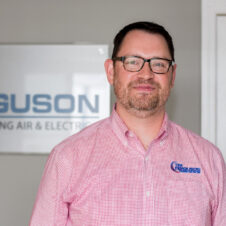 Jacob Hamilton is general manager at Tim Ferguson Plumbing, Air & Electric, a member of the Leap Partners family, operating across Western Tennessee.
Jacob Hamilton is general manager at Tim Ferguson Plumbing, Air & Electric, a member of the Leap Partners family, operating across Western Tennessee.

In the six years since its inception, Women in Energy (WE) has grown rapidly, providing women a variety of opportunities to strengthen their skillset and knowledge base as it relates to their careers in the energy, heating and cooling industries. The organization now has 500 nationwide members and is on a steady growth trajectory. It’s Read more
 In the six years since its inception, Women in Energy (WE) has grown rapidly, providing women a variety of opportunities to strengthen their skillset and knowledge base as it relates to their careers in the energy, heating and cooling industries. The organization now has 500 nationwide members and is on a steady growth trajectory.
In the six years since its inception, Women in Energy (WE) has grown rapidly, providing women a variety of opportunities to strengthen their skillset and knowledge base as it relates to their careers in the energy, heating and cooling industries. The organization now has 500 nationwide members and is on a steady growth trajectory.
It’s worth mentioning that WE is not exclusive to women, and neither are its myriad learning and networking opportunities. Its mission, to connect and empower women working in the energy industry, extends to anyone looking to improve themselves and make an impact on the industry.
WE provides career resources, creates networking and mentoring opportunities, offers online and in-person educational courses and develops strategies to minimize obstacles women may face in the industry. The organization hosts an annual conference, weekly webinars, regional networking events, an upcoming golf outing, and now, a new online learning center called the learning portal, called the E-Learning Library, launched in September 2022.

“With all of our recorded Webinar Wednesday sessions, our educational library has grown to be pretty expansive,” said Judy Garber, WE Executive Director. “We’ve consolidated all of this content in the easy-to-access E-Learning Library on the WE website. Members can access this material wherever and whenever they wish.”
The material covers everything that someone relatively new to the industry – or someone who just changed positions – may benefit from; soft skills, leadership, legal, technical, personal development, etc. At one WE meeting feedback from participants suggested that basic information on various types of energy and HVAC technology was needed.
“We love identifying needs and providing meaningful solutions,” said Erin Holohan Haskell, WE President. “For instance, some of our members in marketing and customer service roles expressed an interest in learning more about the technical aspects of our industry to better assist their customers and expand their knowledge. This feedback gave us real direction in regard to the learning opportunities we wanted to create next.”
As a result, WE developed material on a wide variety of energy technologies. A small sample of the courses offered include Residential Heating 101, Heating System Basics, Biodiesel and Renewable Diesel 101, Heat Pumps 101, Introduction to Solar, Wind Energy 101, and Geothermal Basics.
The E-Learning Library is a great resource for business owners and managers to bring new employees up to speed, or for members to learn on their own.
“We realize that professionals are busy and may not be able to attend our live Webinar Wednesdays or in-person programming,” said Holohan Haskell. “This gives them the opportunity to access valuable content on their own timeline. And there’s content for everyone; those who are new to our industry as well as more experienced professionals.”
“One of the great joys I’ve found in working with WE is that we can move quickly to answer a need,” continued Holohan Haskell. “We’re small and new enough to be nimble. We think ‘what if?’ and then make ‘what if’ happen. In reality, that’s how WE was founded, and we’ve continued doing that. For a small organization, we’ve managed to get a lot done in a short time, thanks to the strong leadership of Judy Garber and a very engaged group of officers and members.”

(Left to right) Jacqueline Aceituno accepts the Judy Garber Rising Star Award from Judy herself. Photo Credit: Andrew Frongillo
The rapid growth exhibited by the organization speaks to the need for the resources that WE provides.
Benefits of annual membership far outweigh the $75 individual member investment. In addition to unlimited access to training, membership includes discounts to events, access to networking opportunities, mentorship, etc. Various levels of WE membership are available, from individual to a tiered corporate structure.
“We encourage people interested in WE to attend our annual conference or one of our other events,” said Garber. “These events are engaging, fun, and offer a great opportunity to see what we’re all about.”
The 2023 WE Conference will be held in Hershey, PA, from September 20 through 22. Also, WE’s second annual golf tournament will be held on October 9, 2023, at the Hershey Country Club.
“Business relationships are often strengthened on the golf course, but we’ve noticed that women often sit out of industry tournaments because they’re unfamiliar with the sport,” said Holohan Haskell. “WE is dedicated to providing our members with career resources to help them succeed in business, so we partnered with the Pennsylvania Petroleum Association on a tournament for golfers of all skill levels.”
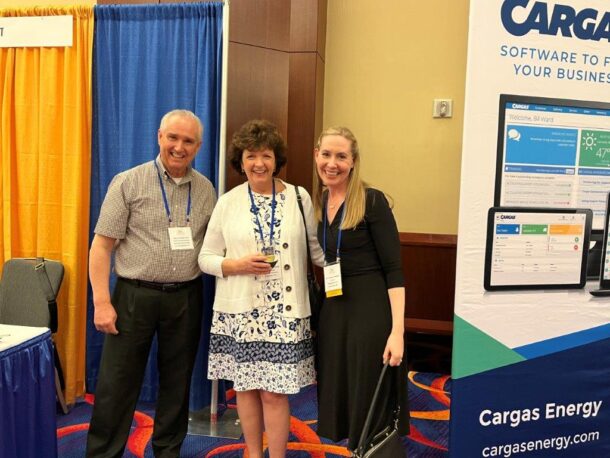
(Left to right) Gary Cooperrider, Rosemarie Bartchak and Erin Holohan Haskell during a WE networking reception Photo Credit: Marjorie Feinman
Before the tournament begins, WE hosts an instructional session with a golf pro for those interested in learning the basics. If members are unfamiliar with golf, this was the perfect opportunity for them to learn the sport so they can participate in future networking opportunities on the golf course.
There are also numerous regional events held throughout the year. These events can be found listed at the WE website. For more information, please visit www.wewomeninenergy.com. The E-Learning Library can be accessed at E-Learning Library – Women in Energy (wewomeninenergy.com).
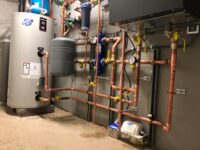
Homeowner’s Mid-January Crisis Resolved by New Jersey Contractor Surprisingly warm temperatures greeted residents of Mid-Atlantic states In the middle of January. For people living in the area who typically face freezing temperatures, severe nor’easter snowstorms, and perilous ice storms, temperatures ranging from the mid-30s to low-40s without precipitation was almost a best-case scenario for the Read more
Homeowner’s Mid-January Crisis Resolved by New Jersey Contractor
Surprisingly warm temperatures greeted residents of Mid-Atlantic states In the middle of January. For people living in the area who typically face freezing temperatures, severe nor’easter snowstorms, and perilous ice storms, temperatures ranging from the mid-30s to low-40s without precipitation was almost a best-case scenario for the residents’ safety – and thermal comfort.
Despite the mild atmospheric conditions that occurred last January, homeowners who have a malfunctioning boiler, even in tranquil weather, may unexpectedly find themselves in a catastrophe at home. This was the situation a homeowner from New Jersey faced when the heating unit of a century-old home stopped working, causing the residents to shiver as evening temperatures approached the freezing point.
Ezzy Travis, a plumbing and heating contractor and solo proprietor of E. Travis Mechanical installed a HTP ELU 150K BTU boiler to substitute the feeble and inefficient one. Four days without heat or water might not seem like a lot, but can seem like an eternity for people living in the house.
“The boiler was only about 12 years old, but was not properly serviced,’’ Travis said. “With the amount of time it would’ve required to repair the boiler, it didn’t make sense. It also wasn’t piped 100 percent correctly.”
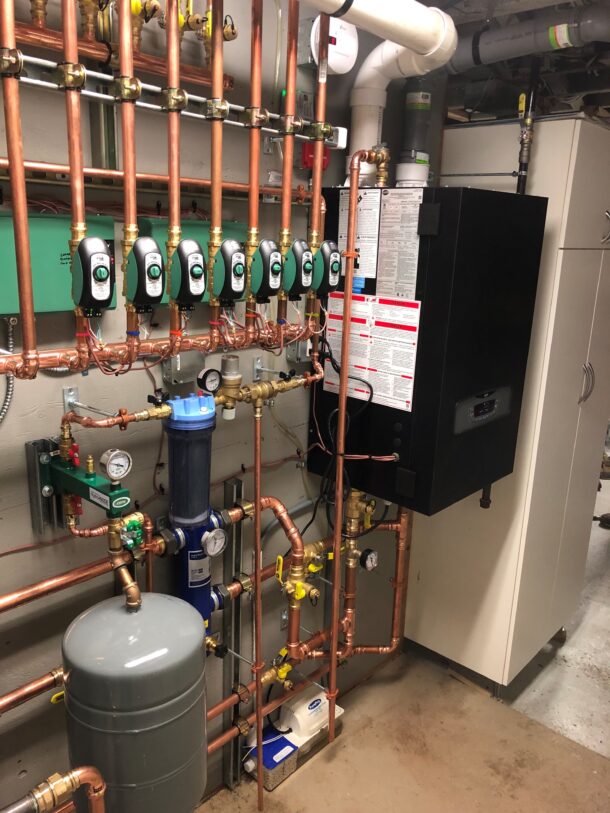
Workers from E. Travis Mechanical replaced the heating system in a century-old New Jersey home when the existing system failed during January, one of the coldest months of the year in the Garden State.
A Fresh Start
Prior to arriving at the home in the New Jersey neighborhood of Glen Rock, Travis had already fixed other home heating emergencies. Upon assessing the situation, he recognized the project required extensive repairs, rather than a short-term solution.
“A wholesaler referred this project to me,’’ Travis said. “I knew right away we’d have to replace the boiler and all the piping. Things weren’t done 100 percent correctly, and I have a standard way of doing things. All the piping in the mechanical room and the boiler had to be ripped out. The only thing that was salvageable was the indirect tank. It had been installed in August, so there was no reason to rip it out.”
Constructed in 1916, the traditional house features four bedrooms and three baths, in a 3,200 square feet area. Despite the house being quite expansive, the mechanical room’s workspace did not have the same luxury.
“That was probably the biggest challenge we faced,’’ he said. “It wasn’t a deep mechanical room. There just wasn’t a lot of room for two of us. I needed another set of hands for this one. We had to ask each other to move out of the way when we had to move within the room. It was a pretty tight squeeze with some significant space constraints.”
Contractors often encounter working areas that are cramped like a sardine can. “It’s weird because many times when you need space, you don’t have it,’’ Travis said. “Other times we’ll install something that is relatively small, and we have all the space in the world. A lot of my jobs are in areas where everybody wants to utilize every square inch of the basement. I’ll have to spend time putting down protective material for the carpet and wall, which makes it take longer. I don’t want to do any damage to the house.”
Navigating tight staircases with burdensome boilers is a risk that contractors frequently experience. When setting up the new boiler to replace the faulty one, Travis and his helper maneuvered carefully as they removed the old unit and installed the new one.
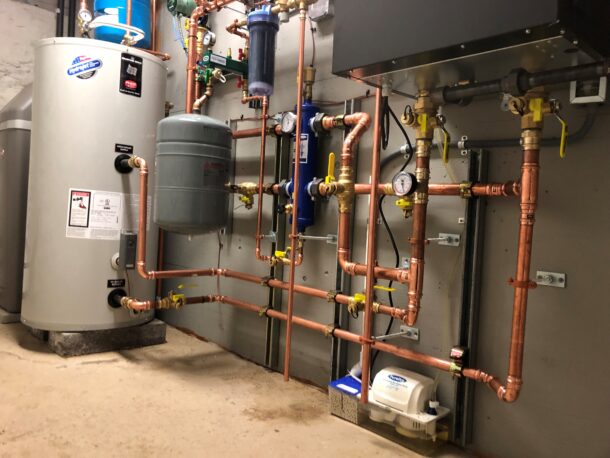
The project included the installation of an HTP ELU 150K boiler, which was selected for its durability and 11:1 turndown ratio.
Turning Up the Heat
Finding the appropriate boiler is key for a project in an old home with many rooms and floors. Contractors must consider that houses with compromised insulation and large square feet make the selection even more important.
“I had to factor in the heat loss of the house,’’ Travis said. “In this part of New Jersey, we see a lot of houses like that. In a hydronic system, you need to do thorough heat loss analysis. I wanted to make sure that the unit we installed was able to overcome any heat loss within the house.”
The high BTU output the HTP boiler provides was the deciding factor in Travis’ choice. “I also liked the fact that it had a 11:1 turndown ratio,’’ Travis said. “I like the simplicity of it. It’s not a complicated boiler. Because of the age of the house, I was also concerned about heat loss. I wanted to make sure we had enough BTUs to heat the entire house.”
In nearly all residential heating systems, the 11:1 ratio is a significant factor to consider. Whenever a boiler or burner finishes a cycle, it uses a substantial amount of energy. Reducing the amount of complete on and off cycles by utilizing a higher turndown ratio can minimize inefficiencies, resulting in lower maintenance costs. Additionally, high turndown burners are capable of responding more rapidly to changes in demand.
The HTP units – offered in sizes from 85K BTU input and all the way up to 199K BTU input – feature high-quality stainless-steel heat exchangers that guarantees the highest quality at the boiler’s core with corrosion resistance. The amplification in water flow provided by the heat exchanger results in increased turbulence that helps scrub the internal walls, thus reducing the accumulation of hazardous deposits.
“I liked the simplicity of this boiler,’’ Travis said. “There are not a lot of moving parts and it’s pretty uncomplicated.”
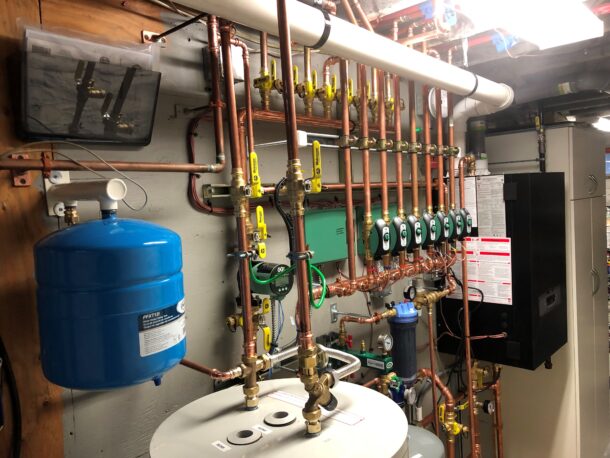
The HTP ELU boiler includes a Wi-Fi solution that enables remote monitoring and notifies personnel when faults occur in the system.
Linked Together
With the help of HTP link technology, the HTP ELU boiler offers a Wi-Fi solution for remote observation and alerts staff in the instance of a system fault. The boiler’s settings can also be conveniently adjusted on location without getting up from the chair.
During his 20-plus years in the industry, Travis has suggested HTP units for several projects. “I like their efficiency, durability and simplicity,’’ he said. “I get a lot of support when I’m installing them. They’ve been a good product for me over the years.”
Despite primarily being a one-man team, Travis takes pride in resolving significant or minor issues for all his clients. “I don’t feel like I’m doing anything special,’’ he said. “I’m just doing what I do. Fortunately, we were able to come up with a good solution for this rather quickly. It’s never a good thing for a homeowner to be without heat in the middle of winter.”
Brian Giardina writes on building, construction, engineering and other trade industry topics for publications throughout the United States.

Peak Season Plumbing Problem During winter, not having hot water can be an aggravating experience for any homeowner. But if a hotel owner must deal with hot water interruption during the holiday season, the issue becomes much more disruptive and severe. A hotel in the Philadelphia area with 88 rooms faced this problem just before Read more
Peak Season Plumbing Problem
During winter, not having hot water can be an aggravating experience for any homeowner. But if a hotel owner must deal with hot water interruption during the holiday season, the issue becomes much more disruptive and severe.
A hotel in the Philadelphia area with 88 rooms faced this problem just before Christmas when its water heating system failed. Normally, plumbing contractors are used to emergency service requests, but with a snowstorm on the way, an increased number of guests and the holidays arriving, this situation required particularly quick action.
The team at Affordable Fixes Heating Cooling Plumbing completed the task by installing two HTP Phoenix tanks, with each holding a capacity of 119 gallons and 199K BTU respectively. Tackling this task required the team to remove four faulty water heaters that were leaking and generating carbon monoxide in the building.
“There are always challenges but replacing four and putting in two meant we had to put in a new exhaust, re-pipe the system, and re-do the electric units,’’ said Val Savkin, owner of Affordable Fixes Heating Cooling Plumbing. “It was supposed to be a one-day job. It took three, which was very efficient given the scope of the project.”
Due to prior communication with the building owner, Savkin knew the condition of the system. When he received a call shortly preceding he holiday season, he knew his help would be needed.
“This was an emergency project,’’ Savkin said. “The water heaters that had been in place had deteriorated. They couldn’t be repaired any longer. It was just wear and tear, they were outdated. Just two days before Christmas we were out there in the snow getting the project finalized.”
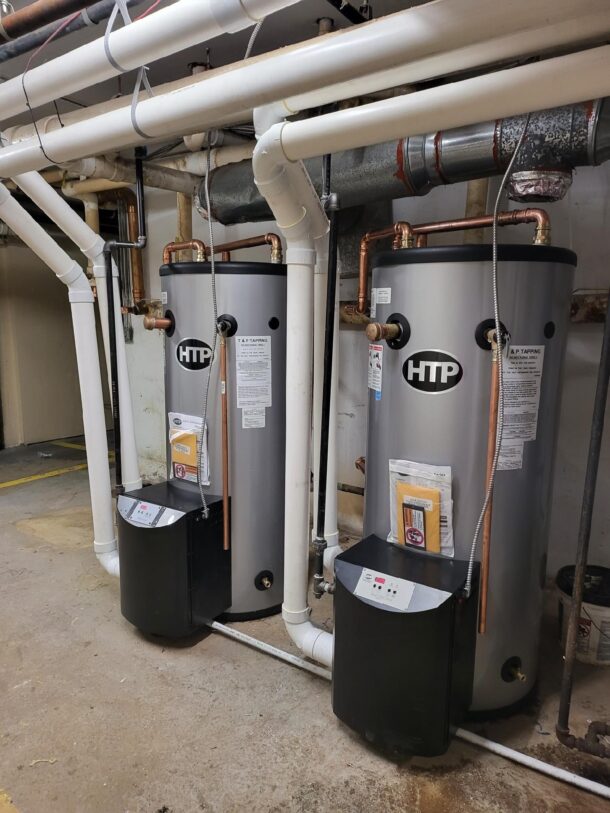
Photos by Affordable Fixes Heating Cooling Plumbing
Before Savkin chose the HTP Phoenix units, he explored other possibilities. “These HTP units were new to us, but we wanted a high efficiency, fast recovery water heater. If we had used another system, we would have to put in at least 3 units,’’ Savkin said. “We saved the customer about $12,000 by selecting this system.”
To complete the in-depth project, Savkin deployed a team of four plumbers and a debris scrapper. The initial phase involved the deconstruction and removal of the current units.
The second step proved to be just as demanding as the first step. Electrical wiring, new exhaust and gas lines were all components required for the second phase, due to the new system requiring fewer heating units.
John Monaghan, a HTP National Training Manager assisted the project by evaluating the building’s heat requirements and proposed installing two Phoenix 119-gallon tanks. “That not only saved the building owner a lot of money, but it also allowed us make the installation a little bit quicker,” Monaghan said.
Placing the tanks in the hotel’s basement was no easy task throughout the setup process. “It was a very tight fit. We were fortunate to have an elevator handy,’’ Savkin said. “We had to disassemble the new units, put them in a box, put them in the elevator and then re-assemble them. If there had not been an elevator, we would’ve gone old school and roped them down.”
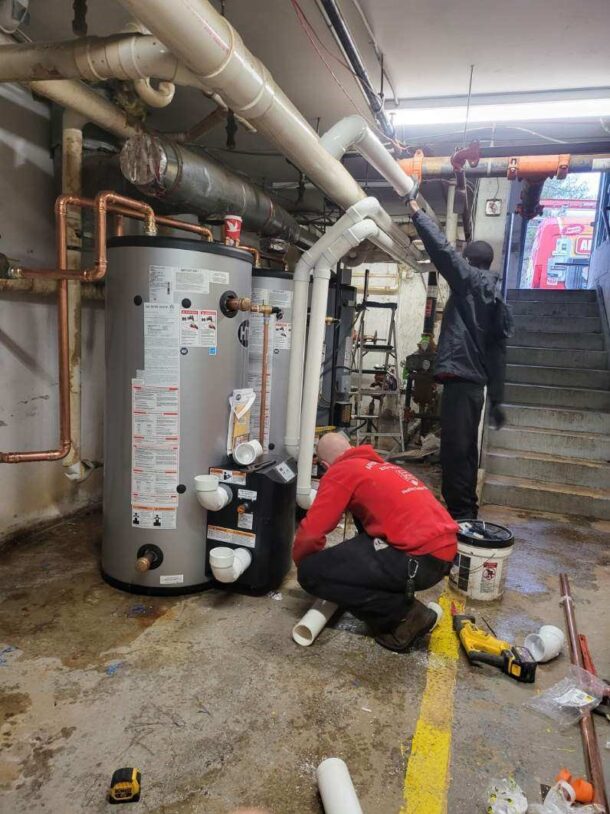
Workers from Affordable Fixes Heating Cooling Plumbing removed four water heaters and installed two HTP Phoenix 119 gallon tanks. Efficiency, durability and fast recovery factored into the decision to install the HTP products.
The selection of the HTP Phoenix water heaters was influenced by several reasons. The water heaters feature energy efficiency, durability and fast recovery that provides thermal comfort for hotel guests in a cost-effective way for the hotel owner.
“We didn’t know much about them, but we recently had training with them and I really liked their efficiency,’’ said Savkin, who has been in business in the Philadelphia area for more than three decades. “They were a great fit with a nice integrated control and easy to replace.”
Boasting a thermal efficiency rating of 96, the HTP Phoenix effectively uses 96 cents of every dollar towards heating purposes. On the other hand, a standard efficiency unit has a maximum capacity of a 60 percent efficiency rating, making the HTP Phoenix a significant upgrade. Operating at a 5:1 turndown ratio, the HTP Phoenix’s modulating burner delivers productive system efficiency even when the load is low.
To prevent corrosion, the HTP Phoenix comes with a 316L stainless steel tank. Furthermore, the unit includes a 7-year warranty for residential use and a 3-5-year warranty for commercial purposes.
“Most times you’ll get 8-12 years out of units, but like anything else it depends how much you take care of it,’’ Savkin said. “I could see these lasting 12-20 years. It’s all about the maintenance of the equipment, but it’s important to look at the water quality, too. The hardness and chemicals of the water has a lot to do with the longevity of the system.”
Receiving emergency service requests is typical for many plumbers, including Savkin. Having no access to heat or cold water will irritate any hospitality owner or homeowner, particularly during peak season.
“When we first looked at this project, we gave the owner a price and he didn’t get back to us right away,’’ Savkin said. “Then he called back and said he needed to have it done immediately. It’s an occupied hotel, and we are right around the corner. With the snow, the holidays and people traveling, this could have been a bad situation for him. We were glad to help him out and fix it quickly.”
Brian Giardina writes on a wide range of trade industry topics for publications throughout the United States.
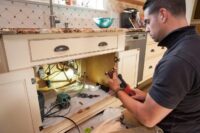
Domestic Water’s Creepy Challenge It’s a, well, creepy sort of problem. That is, when hot water recircs lose their ability to govern themselves. So, there’s the problem. But, let’s back up just a bit. Let’s start with an explanation. Then we’ll talk to the experts. There’s little debate that residential or light commercial domestic hot Read more
Domestic Water’s Creepy Challenge
It’s a, well, creepy sort of problem. That is, when hot water recircs lose their ability to govern themselves. So, there’s the problem.
But, let’s back up just a bit. Let’s start with an explanation. Then we’ll talk to the experts.
There’s little debate that residential or light commercial domestic hot water recirculation (DHWR) technology has proven its value in the world of plumbing and mechanical systems. The devices guard our safety, comfort and health. Hot water recirc systems move potable hot water to fixtures quickly, without waiting for the water to get hot, so there’s less wasted water, and time.
The key challenge to these simple systems is the problem of “hot water creep.” Let’s take a closer look, beginning with an examination of the components that have a role in the recirculation of a home’s domestic hot water.
Let’s first define the “system” After all, the various components, if not connected intelligently and working in concert, would accomplish nothing:
- Water heater without a tempering/mixing valve. Essentially, an unprotected, full-on arrangement that places anyone at risk.
- Water heater with a distribution tempering/mixing valve (typically, and ASSE 1017, or ASSE 1070 valve). This is most common, and became the point of introduction for DHWR systems.
- Water heater with distribution tempering/mixing valve with a DHW recirculation pump and a bypass valve or pump located at the domestic water system’s most remote fixture – with use of the cold water line as a means of returning water to the water heater.
- Water heater with distribution tempering/mixing valve with a DHW recirculation pump and a dedicated return line from the most remote fixture on that particular hot water zone. Ideally, this is how a DHWR system is installed.
- Finally, all of the above, to include a control of some means; aquastat, timer or combination control with some kind of logic.
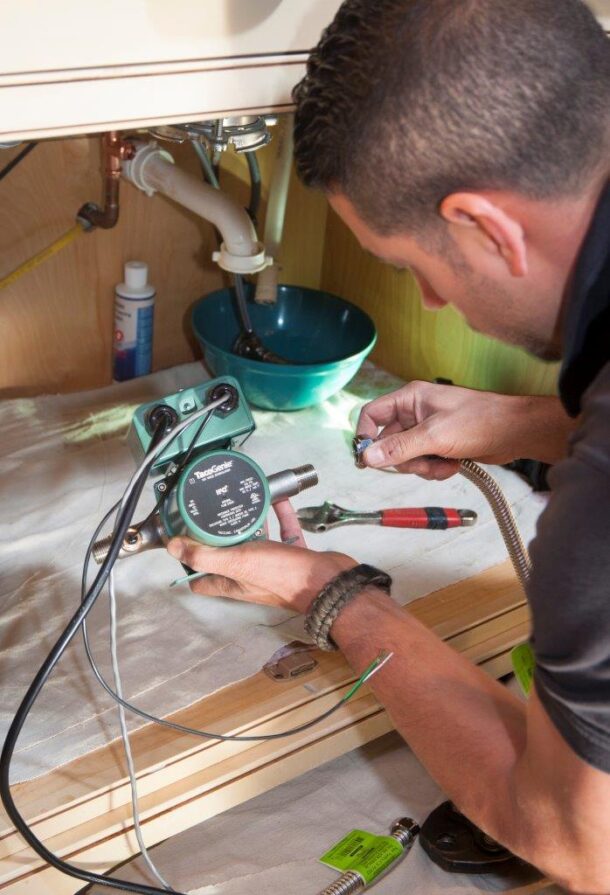
“It takes some, or several of the components above, to make a DHWR system,” explained Rick Mayo, product and applications instructor, Western region, Taco Comfort Solutions.
Most recirc systems, by design, have a tempering valve that continuously adjusts its temperature when water flows through it – while tempering (that is, mixing) it with cold water – to maintain proper outlet water temperature for rapid release at points of use.
The challenge is to maintain the mixed water temp during periods of no demand. The reason for this: the recirc’s pump enables flow through the valve, even when there’s no demand, or draw, from points of use – such as faucets and other fixtures. For this reason, recirc pumps must be piped so that the recirc’s returning flow can reach both the cold connection of the valve as well as the cold connection of the heat source. Some balancing may be required.
Smart, by design
Typically, a water heater’s storage temperature is set for about 140°F for legionella mitigation, and the DHWR’s hot water temperature is reduced to under 120°F at the mixed outlet connection of the valve (with the reduced temp made possible by mixing with cold water, by design).
This cause the valve assembly to adjust temperature; that is, until it reaches the hot water’s set-temp. The internal thermostat adjusts the piston to open the cold port and close the hot port, allowing hot water to recirculate. Unfortunately, there can be challenges to the intended function of these systems.
- Creepy situation #1: If the hot water distribution system isn’t insulated, this can cause the distribution loop temperature to creep down during periods of no demand.
- Creepy situation #2: Domestic water systems installed with a domestic hot water recirculation pump may cause downstream water to overheat if it’s not piped properly or is running longer than required. This overheating of temps within the piped system may go unnoticed for quite a while and could cause risk of scalding at points of use.
Mayo offers this insight: The ASSE 1070 valve does a better job of restricting flow of the hot water than the ASSE 1017 and is more effective at preventing “creep.” He clarifies: “Don’t get me wrong. Those ASSE 1017 valves work as intended in non-recirc systems. If the temperature is set for 115°F, they regulate the temperature to that point, almost assuredly. But as soon as you match ‘em up with a (DHW) recirc, problems can begin.”
- Creepy situation #3: Make sure there’s always sufficient flow to meet the DHWR valve’s minimum flow requirement. All DHWR control valves need a certain amount of flow to function properly. A properly sized, recirc pump will usually assure sufficient flow.
- Creepy situation #4: A point-of-distribution, ASSE 1017 mixing valve (or, for that matter, even the ASSE 1070 valve) that does not have a full or completely closed function for its hot inlet port can cause thermal creep if not properly piped and controlled; many mixing valves with an electronic actuator have a fully-closed position so that this doesn’t occur.
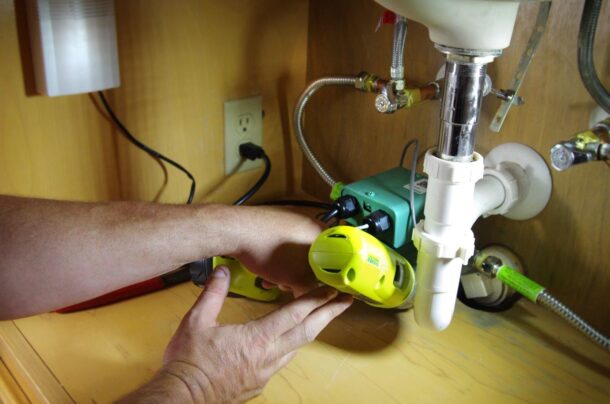
Piped conundrum
“It’s often a piping challenge,” said tekmar’s General Manager, Greg Leupin. “For many hot water recirc ‘creep’ challenges, the challenge has to do with incorrect piping. When the recirc is off or at rest, thermal ‘ghost flow’ can affect the amount of hot water that makes its way into the [distribution] piping.
Leupin added that many recirc loops lack a mixing valve, causing excessive – sometimes unsafe – temperature in the recirc loop, increasing the risk of scalding. This can also lead to inefficiency from heat loss, especially when the domestic water lines aren’t insulated.
Smart technology
Manufacturers have stepped in to help negate the risk of domestic water creep when recirc systems are installed. “Installation instructions are more explicit and the technology’s improved,” said Mayo.
“The problem begins when there’s an inability to dissipate the heat during periods of no demand,” added Mayo. “As referenced earlier Some [DHWR] devices close the hot side better than others, so both the built-in control strategy may help, as does the installation piping. Of course, the recirc shouldn’t be running when the distribution system’s already sufficiently full of hot water, readily accessible at taps and other points of use.”
- Taco SmartPlug (which won AHR Expo’s Product of the Year Award in 2017) was developed to eliminate the hassle of a “timer;” because of their design they only allow water to be circulated for short periods of time, this can help fight the challenge of thermal creep. The small device instantly changes any corded hot water recirc – for instance, those with just timer and on/off function – into a “smart” device by giving it the intelligence it needs to learn a household’s usage patterns to improve and regulate hot water distribution, increasing comfort and efficiency. It can also be set into a ‘pulse only’ mode for light commercial applications, or for homeowners who don’t have a predictable schedule.
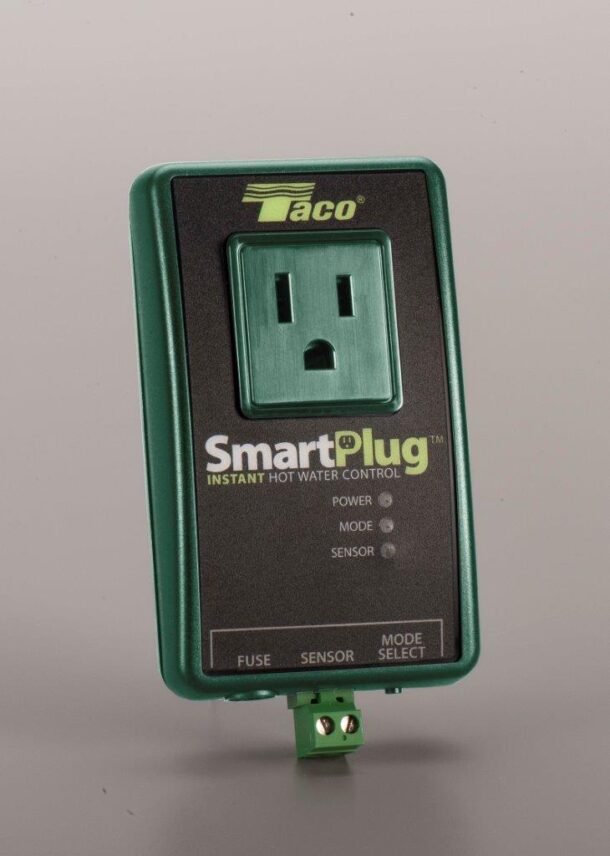
Other hot water recirc solutions include:
- TacoGenie allows homeowners to simply push a button when hot water is desired at a tap, on demand.
- Watts/Premier 500800 – an ideal solution for retrofitting existing domestic water systems with hot water recirc. The device uses the pump at the water heater (though not tankless systems) and an under-sink sensor valve to create a pressure differential – allowing the cold and cool water in the hot water supply line to bypass into the cold water supply line at a low volume through the thermostatically-controlled sensor valve, keeping the water in the hot water supply line at a “no-wait” temperature throughout the home.
ASSE 1070 valve
As Mayo stated earlier, ASSE 1017 thermostatic valves installed at the water heater or heat source may not close off sufficiently in some instances (while the circulator is running) to stop the outward flow of heat. If this happens, and a recirc pump continues to run, temperatures within the distribution piping can creep upward – creating the potential for unexpectedly hot water at taps.
In a situation like that one, the need for hot water [in the distribution piping] is satisfied, but if the [DHWR] pump’s running, ‘creep’ can occur,” concluded Mayo. “Yet another solution protects users from unexpectedly high temps at the tap with or without replacement of the distribution safety valve – and that is the installation of 1016 or 1070 point-of-use valves. They’re most often used for commercial installations, though there are many residential uses of the valves.”
